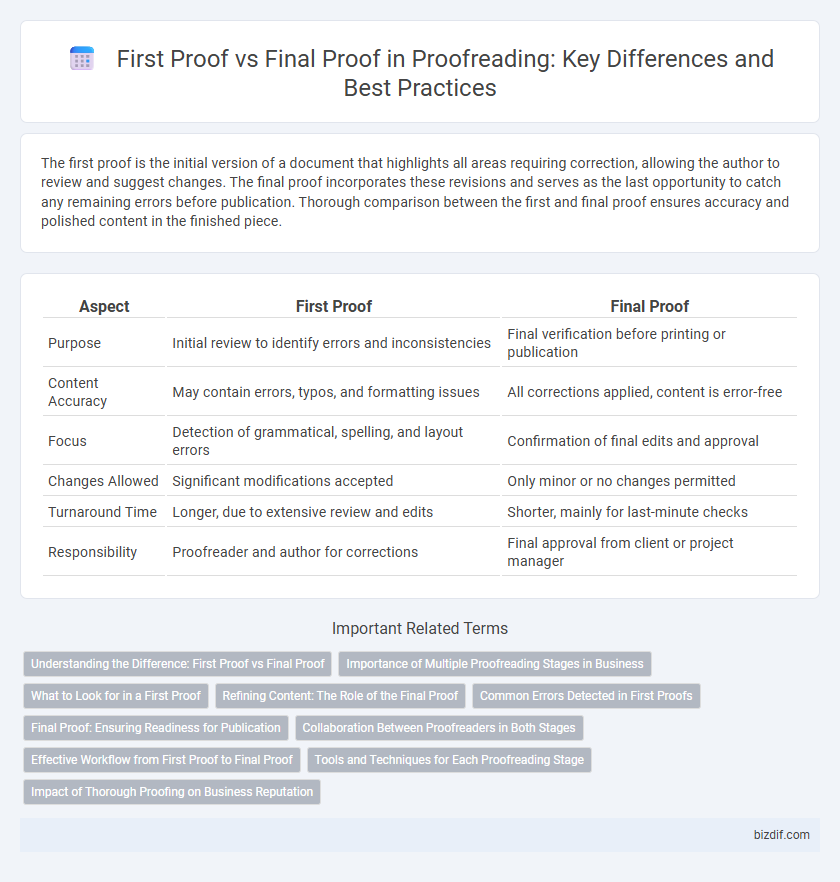The first proof is the initial version of a document that highlights all areas requiring correction, allowing the author to review and suggest changes. The final proof incorporates these revisions and serves as the last opportunity to catch any remaining errors before publication. Thorough comparison between the first and final proof ensures accuracy and polished content in the finished piece.
Table of Comparison
| Aspect | First Proof | Final Proof |
|---|---|---|
| Purpose | Initial review to identify errors and inconsistencies | Final verification before printing or publication |
| Content Accuracy | May contain errors, typos, and formatting issues | All corrections applied, content is error-free |
| Focus | Detection of grammatical, spelling, and layout errors | Confirmation of final edits and approval |
| Changes Allowed | Significant modifications accepted | Only minor or no changes permitted |
| Turnaround Time | Longer, due to extensive review and edits | Shorter, mainly for last-minute checks |
| Responsibility | Proofreader and author for corrections | Final approval from client or project manager |
Understanding the Difference: First Proof vs Final Proof
First proof represents the initial version of a document, allowing for identification and correction of errors before the final stage. Final proof is the last review copy, where only minor adjustments are made to ensure accuracy and quality prior to printing or publishing. Understanding the difference between first proof and final proof ensures efficient proofreading, reducing costly mistakes and enhancing overall communication clarity.
Importance of Multiple Proofreading Stages in Business
Multiple proofreading stages in business ensure accuracy and professionalism by catching errors that may be overlooked in the first proof. The first proof allows initial content review for major errors, while the final proof confirms flawless text ready for publication or distribution. Implementing both stages reduces costly mistakes, enhances brand credibility, and maintains high-quality communication with clients and stakeholders.
What to Look for in a First Proof
In a First Proof, prioritize checking layout consistency, typographical errors, and basic formatting to ensure the document aligns with initial design specifications. Review text accuracy, including spelling, grammar, and punctuation, while verifying that charts, images, and tables appear correctly and maintain proper resolution. Confirm page numbering, headers, footers, and margin settings to catch structural issues before proceeding to the Final Proof stage.
Refining Content: The Role of the Final Proof
The final proof plays a crucial role in refining content by ensuring accuracy, consistency, and overall quality before publication. It addresses any lingering errors or inconsistencies missed during the first proof, enhancing the clarity and professionalism of the text. This stage is essential for verifying typography, spelling, and layout details to deliver a polished final product.
Common Errors Detected in First Proofs
First proofs typically reveal common errors such as typos, punctuation mistakes, formatting inconsistencies, and incorrect data entries. These initial reviews highlight discrepancies in grammar, spelling, and layout that can affect the overall readability and professionalism of the document. Identifying and correcting these errors early minimizes costly revisions in the final proof stage.
Final Proof: Ensuring Readiness for Publication
The final proof serves as the last checkpoint in the proofreading process, focusing on eliminating any lingering errors to ensure readiness for publication. It involves meticulous verification of text, layout, and formatting to maintain consistency and accuracy throughout the document. Achieving a flawless final proof guarantees a professional and polished presentation, essential for printing or digital distribution.
Collaboration Between Proofreaders in Both Stages
Collaboration between proofreaders in the first proof and final proof stages ensures consistent error identification and correction, enhancing overall document quality. During the first proof, collaborative efforts focus on catching initial errors and clarifying ambiguities, while in the final proof, proofreaders verify corrections and confirm adherence to style guidelines. Effective communication and shared annotations between proofreaders streamline transitions between stages, reducing the risk of overlooked mistakes.
Effective Workflow from First Proof to Final Proof
The first proof captures initial errors and sets the foundation for revisions, making it essential to conduct a thorough review for clarity, grammar, and formatting inconsistencies. Applying structured annotations and feedback during this stage streamlines collaboration between authors, editors, and designers, reducing the risk of overlooked mistakes. The final proof confirms all corrections are accurately implemented, ensuring a polished, publication-ready document that meets quality standards and client expectations.
Tools and Techniques for Each Proofreading Stage
First proof utilizes tools such as digital grammar checkers and collaborative commenting platforms to identify major structural, grammatical, and typographical errors efficiently. Final proof relies on manual techniques like line-by-line reading, print-out review, and highlighting to ensure precision, consistency, and error-free formatting before publication. Combining software assistance in initial reviews with meticulous manual inspection in the final stage ensures comprehensive error detection and text refinement.
Impact of Thorough Proofing on Business Reputation
Thorough proofreading in the first proof stage minimizes errors that can damage brand credibility and customer trust, directly impacting business reputation. Final proofs serve as the last safeguard, ensuring all content is flawless before publication to maintain professional standards. Consistently accurate materials reinforce customer confidence and enhance overall market perception.
First Proof vs Final Proof Infographic

 bizdif.com
bizdif.com